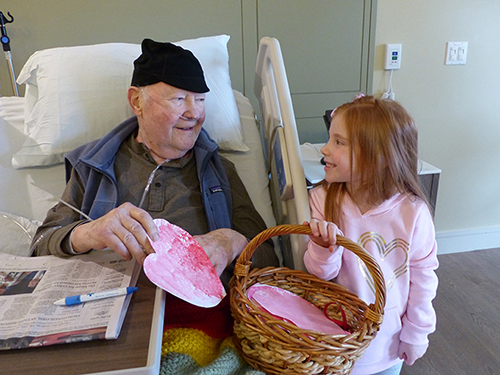How can we help?
888-283-1722
Call us now at 888-283-1722
24/7 Referrals and Nursing Support
Voices of Care Blog

How to Support Your Child When Visiting a Hospice Patient
Posted on March 6, 2024 by Care Dimensions Children’s Program StaffWhen someone important in a child’s life is receiving hospice care, it can be challenging to know how best to support that child. Many parents wonder if their child should be allowed to visit a patient who is dying. Would visiting be too scary or tarnish the child’s happy memories with that person? Would not having a chance to say goodbye result in resentment or guilt? The following tips will help parents and caregivers know how to make the best choice.
Should children visit a patient at end of life?
Yes, if the child would like to visit the patient. It is important to give them the opportunity to do so, regardless of their age. Children often struggle with their experience because they believe they did not have a choice or their feelings were not considered. If your child wants to visit, here are some ways to help ensure the experience is a safe and comforting one.
Preparing your child for a visit:
- Make your child aware of any changes in the patient’s condition.
- “Grammy may be sleepier than usual, her breathing may sound different and she might have her mouth open. Grammy might not be able to talk to you, but if you talk to her, she can still hear you.”
- Prepare your child for changes in the patient’s environment.
- Is there new medical equipment (hospital bed, oxygen, commode, etc.) in the house?
- If the patient is at a hospice house, you can explain:
- A hospice house is “home away from home” for people who are very, very sick. A hospice house is usually much smaller than a hospital; it is very quiet and peaceful.
- There are lots of people to help make the patient feel comfortable (doctors, nurses, social workers, etc.).
- The patient’s room looks like a room in someone’s home so family members and loved ones can bring pictures or other items from home to decorate.
Timing the visit:
- Avoid a visit right before the child’s bedtime to allow for time to decompress and to process feelings.
- Visit when the patient is most comfortable or alert.
- If the patient is in noticeable pain or discomfort, limit the visit or reschedule it.
- If this may be the last time your child sees the patient, be sure they know this.
During the visit:
- Provide ideas for how to interact during the visit.
- “While you are visiting Grammy, you can draw a picture to put by her bedside, sing her a quiet song, read her a book, talk to her, or simply hold her hand. If you would like to visit, but do not want to stay in the room with her, you can play in a different room.”
- Ask your child if they have any questions and be prepared to answer them as honestly and directly as possible.
- If old enough to be unsupervised, ask your child if they might like a few minutes alone with the patient.
Leaving a visit:
- Saying goodbye can bring up difficult feelings. Validate this.
- Make sure your child can identify a supportive adult in their life who can be available to talk about feelings or answer questions. This may be a parent, caregiver, or professional.
- Name the positives of the visit.
- “That was a special picture you made for her.” Or “It means a lot that you visited.”
- If the patient is very close to end of life, avoid making promises like “we will see her again next week.”
If your child does not visit:
- You can ask your child about why they prefer not to visit to ensure there is not an underlying reason that could be addressed.
- Validate your child’s wishes to not visit. It’s okay to not want to go. Avoid making comments that could cause guilt or shame about this choice.
- Let them know they can visit another time if they change their mind. If visiting another time is not possible, make sure the child is aware of that.
- Offer alternatives
- Draw a picture or write a note to be mailed or delivered by another visitor.
- Exchange a picture or video message on a cell phone.
Helping your child process feelings
- Remind your child that it is okay to have many different feelings about a loved one who is so sick. Children sometimes feel sad, scared, angry, happy, relieved, worried, and/or confused. Ask your child about what is most helpful for them when they experience these feelings.
Care Dimensions has a team of child life specialists who can help you decide how much information to share with your child and how to support them while a loved one is receiving hospice care. Contact [email protected] or ask a member of your hospice team to have a child life specialist contact you directly.
Download a PDF of these tips about how to support a child when visiting a hospice patient.
Learn more about our Children’s Program and children’s grief resources.
To be notified when articles are published on the Care Dimensions blog, please email [email protected].
Additional Posts
Memory Making Activities for Children Before and After a Death
Posted on November 17, 2025 by Bridget McHallam, Child Life Specialist Intern in ChildrenFor many children and teenagers, engaging in memory-making activities can be a meaningful way to express love, connection, and remembrance. Here are some suggested activities. ...
Continue readingChildren's Grief Awareness Month: Why it Matters
Posted on October 28, 2025 by Kasey Griffin, MS, CCLS in ChildrenEvery November, we recognize Children’s Grief Awareness Month. Here are some tips on how you can help children who are grieving. ...
Continue readingNot All Spiritual Care Involves Prayer – Sometimes It's About Popcorn
Posted on October 19, 2025 by Stephen Thompson Kohut, Spiritual Counselor in Hospice, Hospice careersNot everyone is religious, but Steve Kohut believes most people are spiritual. That's where his role as a hospice spiritual counselor comes in. ...
Continue readingAnyone—patient, family, care provider—can make a referral. Fill in the form online or call us today.
Since 1978, Care Dimensions, formerly Hospice of the North Shore, has provided comprehensive and compassionate care for individuals and families dealing with life-threatening illnesses. As the non-profit leader in advanced illness care, we offer services in over 100 communities in Massachusetts.
Copyright 2026 | Care Dimensions, 75 Sylvan Street, Suite B-102, Danvers, MA 01923 | 888-283-1722 | 978-774-7566 |









